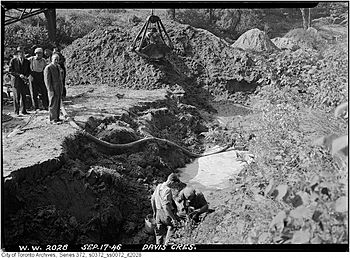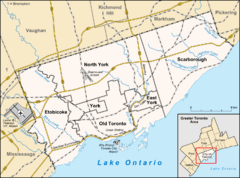Tomlin's Creek facts for kids
Quick facts for kids Tomlin's Creek |
|
|---|---|

After it was buried, and converted into a sewer, tiny springs keep breaking out at the creek's old headwaters.
|
|
|
Historic location of the mouth of the creek in Toronto
|
|
| Country | Canada |
| State | Ontario |
| Municipality | Toronto |
| Physical characteristics | |
| River mouth | Small's Pond 43°40′46″N 79°18′00″W / 43.6795°N 79.300°W |
| Length | 1 km (0.62 mi) |
Tomlin's Creek is a short stream in Toronto, Canada. It used to flow into a larger body of water called Small's Pond. The creek's starting point, or "headwaters," seems to have been in a valley where Glen Davis Crescent is now. People living there still report small springs bubbling up from the ground.
Contents
History of Tomlin's Creek
In the 1800s, Tomlin's Creek was part of a large area of land. This land belonged to Charles Coxwell Small. He was a gentleman farmer, meaning he owned a farm but didn't work it himself. He was also an important public official in Upper Canada (which is now Ontario).
Small's Pond and the Mill
Just north of where Queen Street is today, Mr. Small built a dam. This dam created a millpond, which is a pond used to power a mill. This millpond helped run sawmills, which cut wood. The pond became known as Small's Pond. Tomlin's Creek and other small streams flowed into Small's Pond.
From Clean Water to Pollution
Tomlin's Creek and the other streams flowing into Small's Pond stayed clean for a long time. By the late 1800s, the pond was a popular spot. People enjoyed swimming and fishing there in the summer. In winter, large blocks of ice were cut from the pond to be used for cooling.
However, as Toronto grew, the area around the pond became part of the city. More buildings and people meant more pollution. The creeks quickly became dirty. Because of this, the city decided to bury the creeks. They were turned into underground sewers to carry away wastewater.
Modern Day Concerns
Even though Tomlin's Creek is now buried, its old headwaters still have small springs. Residents who live near these bubbling springs are worried. They fear that dangerous sinkholes could form. A sinkhole is a hole in the ground that opens up when the land above an empty space collapses.
During winter, the water from these springs flows onto the street. This water can freeze, making the roads very slippery and dangerous for driving. This happens even when other streets are clear of ice.


